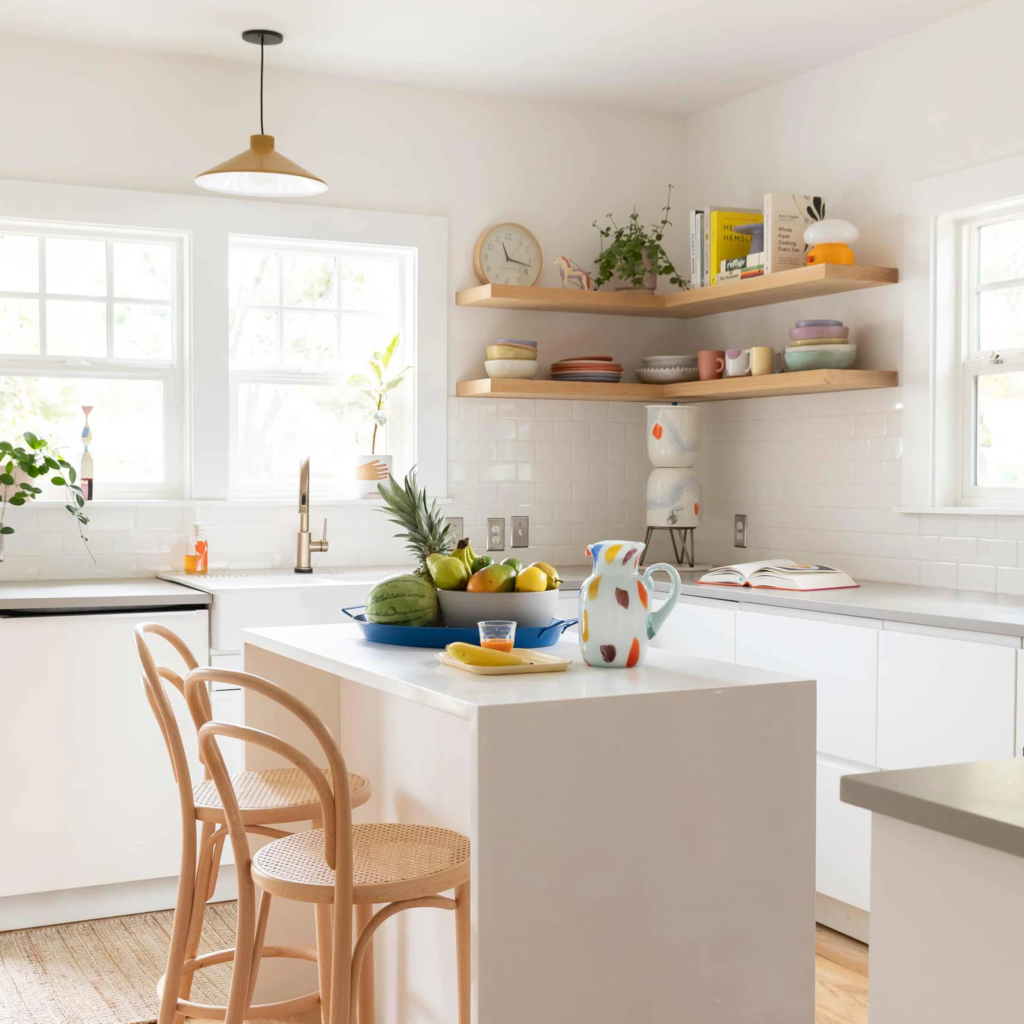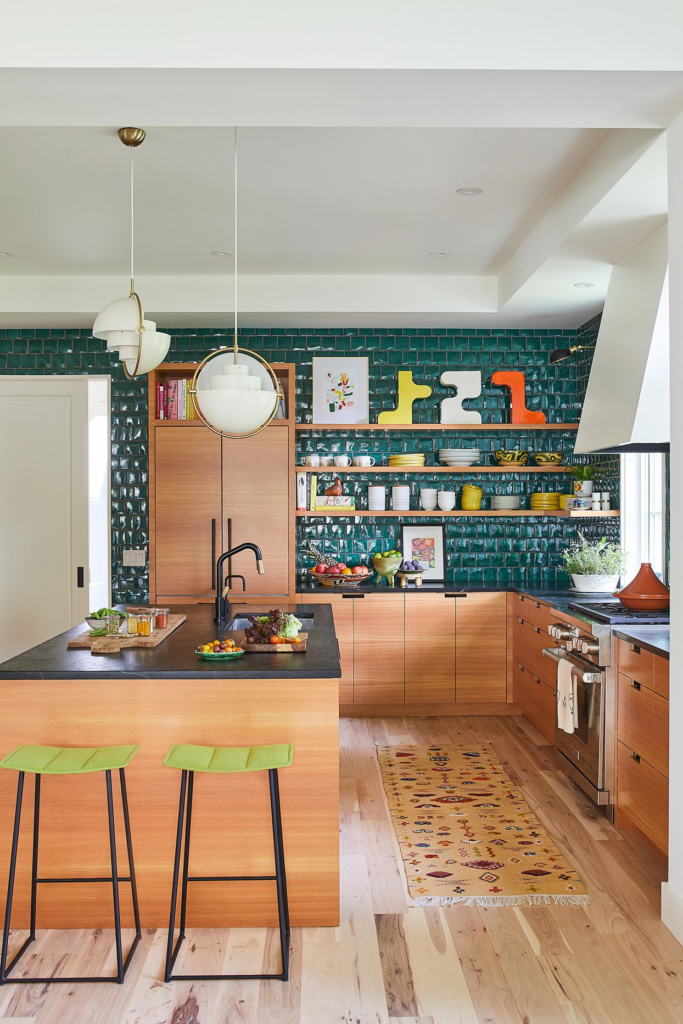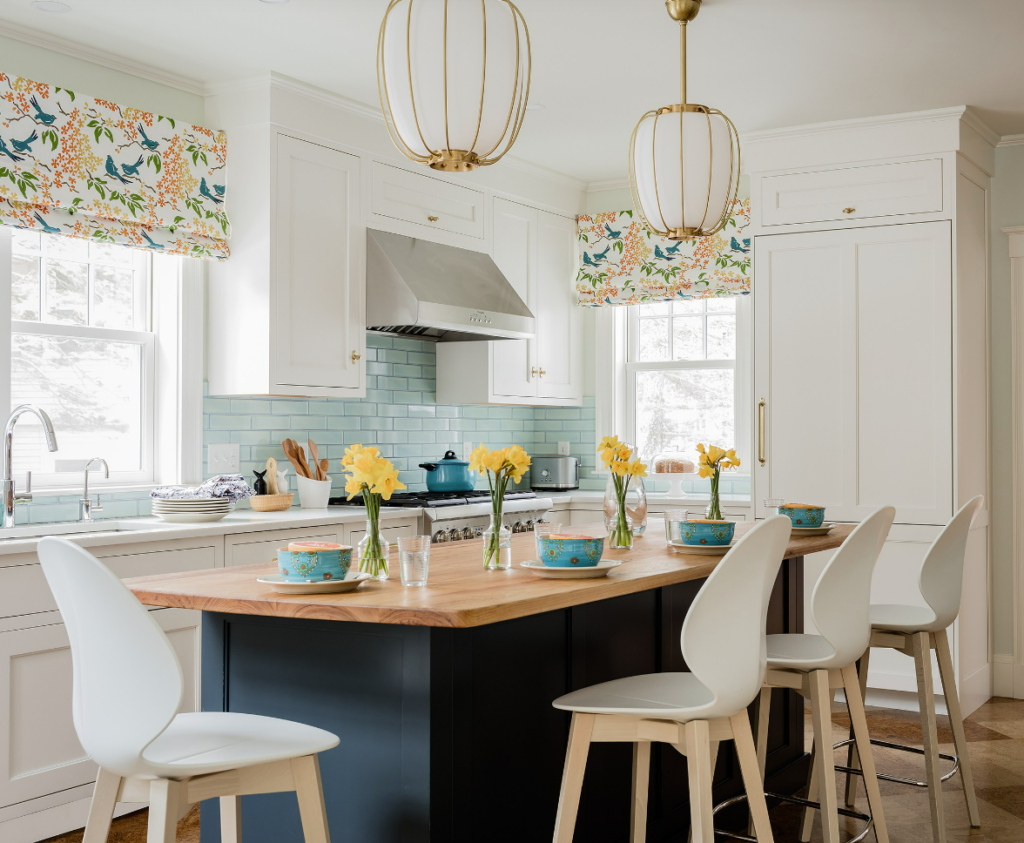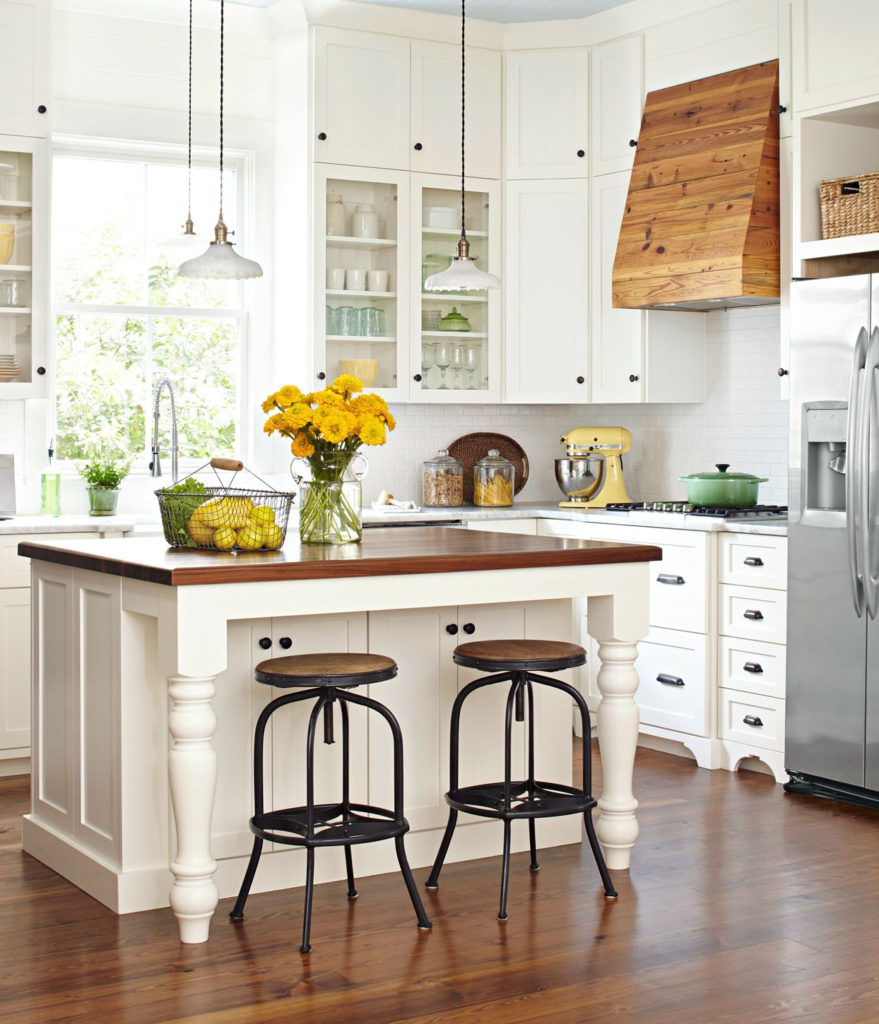
Transform Kitchen with Pops of Color and Neutrals a well-designed kitchen is the heart of the home, where functionality meets style. One of the most effective ways to create a visually appealing kitchen is by balancing pops of color with neutral tones. This combination can add personality to your space while maintaining a sense of elegance and timelessness. In this blog, we’ll explore how to transform your kitchen using pops of color and neutrals, offering inspiration and practical tips to achieve a stunning look.
Table of Contents
1. The Power of Color in Kitchen Design

Color plays a crucial role in defining the ambiance of your kitchen. Whether you prefer bold, vibrant hues or subtle, muted tones, the right color choices can breathe new life into your space.
A. Impact of Color Psychology
Colors can evoke specific emotions and set the mood in your kitchen. Understanding color psychology can help you choose the right shades to create the desired atmosphere:
- Warm Colors (Red, Orange, Yellow): These colors are energizing and can stimulate appetite, making them ideal for kitchens where family gatherings and meals take center stage.
- Cool Colors (Blue, Green, Purple): Transform Kitchen with Pops of Color and Neutrals Cool tones create a calming and relaxing environment, perfect for a serene and peaceful kitchen.
- Neutrals (White, Gray, Beige): Transform Kitchen with Pops of Color and Neutrals Neutral colors provide a versatile backdrop that complements any color scheme. They create a sense of balance and sophistication in the kitchen.
B. Choosing the Right Pop of Color
When adding pops of color to your kitchen, consider the following factors to ensure a harmonious and cohesive look:
- Complementary Colors: Transform Kitchen with Pops of Color and Neutrals Choose colors that complement your existing kitchen palette. For example, if your kitchen has neutral cabinets, consider adding a pop of color through accessories like bar stools, rugs, or small appliances.
- Accent Walls: Transform Kitchen with Pops of Color and Neutrals Paint one wall in a bold color to create a focal point in your kitchen. This can add depth and interest to the space without overwhelming it.
- Color Zones: Transform Kitchen with Pops of Color and Neutrals Use color to define specific zones in your kitchen, such as the cooking area, dining space, or breakfast nook. This can create a dynamic and visually appealing layout.
2. The Elegance of Neutrals

Neutrals are the foundation of many kitchen designs, offering a timeless and versatile backdrop that allows other elements to shine. They create a clean and sophisticated look that can be easily updated with changing trends.
A. Benefits of a Neutral Palette
- Versatility: Transform Kitchen with Pops of Color and Neutrals work well with any style, from modern to traditional. They provide a flexible canvas that can be paired with various colors, textures, and materials.
- Light and Space: Transform Kitchen with Pops of Color and Neutrals Light neutral colors, such as white or beige, can make a small kitchen appear larger and more open. They reflect natural light, creating a bright and airy atmosphere.
- Timeless Appeal: Transform Kitchen with Pops of Color and Neutrals tones are classic and never go out of style. They ensure your kitchen remains elegant and relevant, even as design trends evolve.
B. Incorporating Neutrals into Your Kitchen
- Cabinetry: Transform Kitchen with Pops of Color and Neutrals Choose neutral-colored cabinets for a clean and cohesive look. White, gray, or taupe cabinets create a timeless foundation that can be easily updated with colorful accents.
- Countertops: Transform Kitchen with Pops of Color and Neutrals countertops in materials like quartz, marble, or granite provide a sleek and sophisticated surface that complements any color scheme.
- Backsplashes: A neutral backsplash can tie your kitchen design together. Consider subway tiles in white or gray for a classic and understated look.
3. Balancing Pops of Color with Neutrals

The key to a well-designed kitchen lies in balancing bold pops of color with soothing neutrals. This contrast creates a dynamic and visually engaging space that feels both lively and inviting.
A. Strategic Placement of Color
When incorporating pops of color into your kitchen, it’s essential to strategically place them to enhance the overall design:
- Accent Pieces: Transform Kitchen with Pops of Color and Neutrals Introduce color through small, easily changeable elements like bar stools, pendant lights, or decorative items. This allows you to update the look of your kitchen without committing to a permanent change.
- Appliances: Transform Kitchen with Pops of Color and Neutrals Brightly colored appliances, such as a red toaster or a blue mixer, can add a fun and playful touch to your kitchen while still maintaining a cohesive look.
- Artwork and Decor: Transform Kitchen with Pops of Color and Neutrals Display colorful artwork, vases, or plants to infuse your kitchen with personality. These pieces can be easily swapped out to refresh the space.
B. Creating Contrast with Neutrals
Neutrals act as a balancing force, grounding the pops of color and preventing the space from feeling too overwhelming:
- Neutral Cabinets with Colorful Backsplash: Transform Kitchen with Pops of Color and Neutrals Pair neutral-colored cabinets with a vibrant backsplash to create a focal point that draws the eye and adds interest to the kitchen.
- Colorful Cabinets with Neutral Countertops: Transform Kitchen with Pops of Color and Neutrals If you prefer bold cabinet colors, balance them with neutral countertops to keep the design grounded and cohesive.
- Neutral Walls with Bold Accents: Transform Kitchen with Pops of Color and Neutrals Keep the walls neutral to allow colorful furniture or accessories to take center stage. This creates a balanced and harmonious look.
4. Exploring Color Combinations

Choosing the right color combination is crucial to achieving a cohesive and stylish kitchen design. Here are some popular color pairings that work well in modern kitchens:
A. Gray and Yellow
- Why It Works: The combination of gray and yellow creates a modern and cheerful kitchen. Gray provides a sleek and sophisticated backdrop, while yellow adds a pop of brightness and energy.
- How to Use It: Transform Kitchen with Pops of Color and Neutrals Pair gray cabinets with yellow accents, such as bar stools, pendant lights, or kitchen utensils. This combination works well in both contemporary and industrial-style kitchens.
B. White and Blue
- Why It Works: Transform Kitchen with Pops of Color and Neutrals White and blue is a classic combination that evokes a sense of calm and freshness. This pairing is perfect for coastal or farmhouse-style kitchens.
- How to Use It: Transform Kitchen with Pops of Color and Neutrals Choose white cabinets and countertops, and add pops of blue through tiles, accessories, or small appliances. This creates a serene and inviting kitchen space.
C. Black and Red
- Why It Works: The bold contrast between black and red creates a striking and dramatic kitchen design. This combination is ideal for modern or eclectic kitchens.
- How to Use It: Transform Kitchen with Pops of Color and Neutrals Use black as the dominant color for cabinets or countertops, and introduce red through accent pieces like chairs, rugs, or wall art. This pairing adds energy and sophistication to your kitchen.
D. Beige and Green
- Why It Works: Transform Kitchen with Pops of Color and Neutrals Beige and green create a warm and earthy kitchen that feels both cozy and inviting. This combination is perfect for traditional or rustic kitchens.
- How to Use It: Transform Kitchen with Pops of Color and Neutrals Start with beige cabinets or countertops, and add green through plants, backsplash tiles, or kitchen textiles. This creates a natural and harmonious space that feels connected to the outdoors.
5. Enhancing the Design with Textures and Materials

Textures and materials play a crucial role in elevating the overall design of your kitchen. Combining different textures with pops of color and neutrals can add depth and dimension to the space.
A. Textured Backsplashes
A textured backsplash can add visual interest and break up the monotony of a neutral kitchen. Consider materials like:
- Subway Tiles: Transform Kitchen with Pops of Color and Neutrals Classic and versatile, subway tiles in a neutral color can be paired with colorful grout for a subtle pop of color.
- Mosaic Tiles: These tiles come in various colors and patterns, adding a vibrant and artistic touch to your kitchen.
- Brick: Transform Kitchen with Pops of Color and Neutrals For a rustic or industrial look, consider a brick backsplash in neutral tones. Pair it with colorful accents to create a balanced design.
B. Wood Elements
Incorporating wood elements into your kitchen can add warmth and a natural touch that complements both pops of color and neutrals.
- Wooden Cabinets: Transform Kitchen with Pops of Color and Neutrals Choose wooden cabinets in a neutral tone, such as oak or walnut, to add texture and depth to your kitchen. Pair them with colorful accessories for a balanced look.
- Wooden Shelves: Transform Kitchen with Pops of Color and Neutrals Open wooden shelves provide a perfect spot to display colorful dishware, plants, or decorative items, adding personality to your kitchen.
- Wooden Flooring: Transform Kitchen with Pops of Color and Neutrals Neutral wood flooring creates a warm and inviting foundation for your kitchen design. It pairs well with both bold colors and soft neutrals.
C. Metal Accents
Metal accents can add a modern and sleek touch to your kitchen. Consider incorporating metals like:
- Stainless Steel Appliances: Stainless steel is a popular choice for modern kitchens, offering a neutral yet stylish backdrop that complements any color scheme.
- Brass or Copper Fixtures: These warm metals can add a touch of luxury and elegance to your kitchen. Pair them with neutral cabinets and colorful accents for a balanced look.
- Metallic Backsplashes: A metallic backsplash in silver, gold, or bronze can create a striking focal point in your kitchen. Pair it with neutral tones to let the metallic shine.
6. Tips for a Cohesive and Stylish Look

Achieving a cohesive and stylish kitchen design is all about balance and intentionality. Here are some essential tips to ensure that your kitchen harmoniously blends pops of color with neutral tones while maintaining a polished and unified appearance.
A. Stick to a Consistent Color Scheme
A well-thought-out color scheme is the backbone of any cohesive kitchen design. When working with both bold colors and neutrals, it’s crucial to keep the palette consistent throughout the space.
- 3-Color Rule: Limit your color palette to three main colors—a dominant neutral, a secondary color, and an accent color. This approach helps maintain balance and ensures that your kitchen doesn’t feel overwhelming or chaotic.
- Varying Shades and Tones: Incorporate different shades and tones of your chosen colors to create depth and visual interest. For example, if you’ve chosen blue as your pop of color, you might use a soft pastel blue for accessories, a medium blue for backsplash tiles, and a deep navy for bar stools.
B. Create Focal Points
Strategically place pops of color to draw attention to specific areas of your kitchen. This not only adds visual interest but also helps to guide the eye and create a sense of flow.
- Accent Walls: Painting one wall in a bold color or using a vibrant wallpaper can create a stunning focal point. This is particularly effective in open-plan kitchens, where a colorful wall can help define the space.
- Statement Pieces: Incorporate a standout element, such as a colorful kitchen island, a unique light fixture, or a vibrant piece of artwork. These items can serve as the centerpiece of your kitchen, anchoring the design and bringing all the elements together.
C. Balance Bold and Subtle Elements
While pops of color can add energy and personality to your kitchen, it’s important to balance these with more subdued, neutral elements to avoid visual overload.
- Neutral Counterparts: For every bold element you introduce, ensure there’s a neutral counterpart. For instance, if you have a bright red backsplash, balance it with white or gray cabinets and countertops.
- Layering Textures: Incorporate different textures, such as smooth marble countertops, rough brick backsplashes, or soft wooden floors, to add depth to your design. The interplay of textures can enhance the visual appeal of your kitchen without relying solely on color.
D. Incorporate Natural Light
Natural light plays a significant role in how colors are perceived in a space. A well-lit kitchen can make colors appear more vibrant and neutrals more calming.
- Maximize Windows: If possible, maximize the amount of natural light entering your kitchen by opting for larger windows or skylights. Light neutral colors like white or beige can reflect this light, making the space feel airy and open.
- Consider Light Fixtures: In areas where natural light is limited, carefully select light fixtures that enhance your color scheme. Warm lighting can accentuate earthy tones, while cool lighting can bring out the vibrancy in bold colors.
E. Use Accessories to Tie the Look Together
Accessories are an excellent way to bring your color scheme to life and ensure cohesion across the entire kitchen.
- Coordinated Accents: Choose accessories, such as dishware, textiles, and small appliances, in your chosen accent colors. These items can be easily swapped out, allowing you to refresh your kitchen’s look over time.
- Unified Decor: Use decor items, like vases, artwork, and planters, to echo the colors in your kitchen. This subtle repetition can help to tie all the elements together, creating a harmonious and visually pleasing space.
F. Consider the Overall Style
Lastly, ensure that the use of color and neutrals aligns with the overall style of your kitchen. Whether your kitchen is modern, traditional, or eclectic, the color scheme should enhance and reflect that style.
- Modern Kitchens: For a sleek, modern look, opt for a monochromatic color scheme with one or two bold accents. High-gloss finishes and minimalist design elements can further enhance this style.
- Traditional Kitchens: In a traditional kitchen, rich neutrals like cream, beige, and warm wood tones can be complemented by softer pops of color, such as muted greens or blues.
- Eclectic Kitchens: If your style is more eclectic, feel free to mix and match colors and patterns. The key is to ensure that there’s a unifying element, such as a consistent use of one neutral tone, to keep the design cohesive.
Conclusion:
Transforming your kitchen with pops of color and neutrals is a creative and rewarding process. By carefully selecting your color palette, balancing bold and subtle elements, and paying attention to the overall style, you can create a kitchen that not only looks stunning but also feels uniquely yours. Whether you’re drawn to the energy of bright colors or the calm of neutral tones, the right combination can make your kitchen the true heart of your home.
